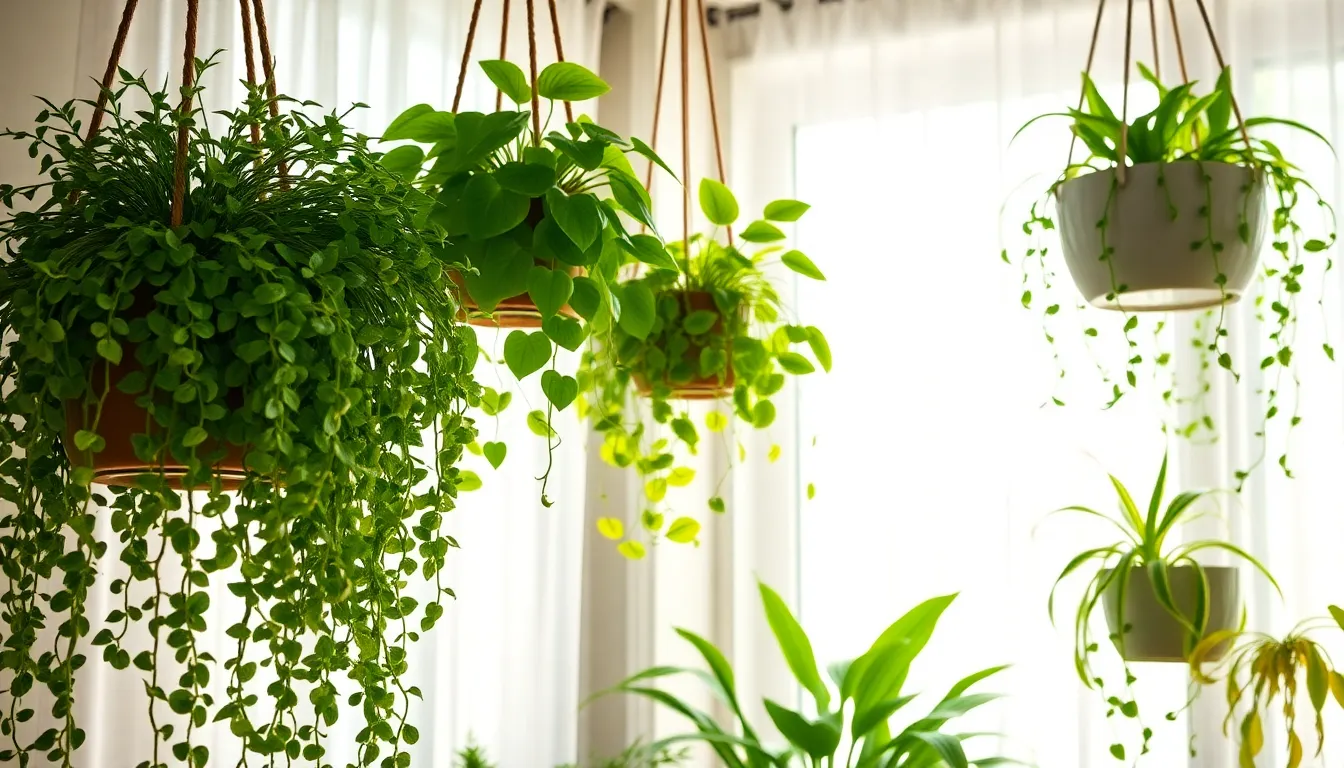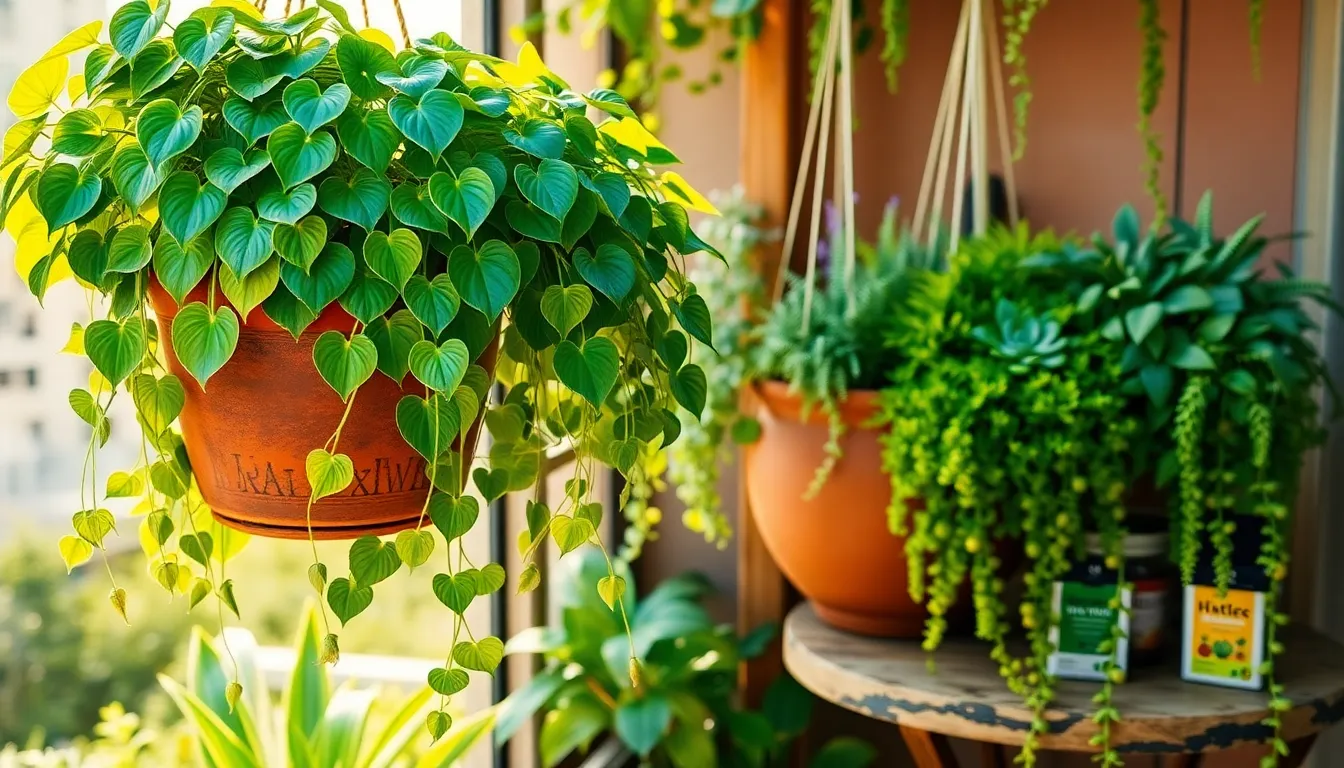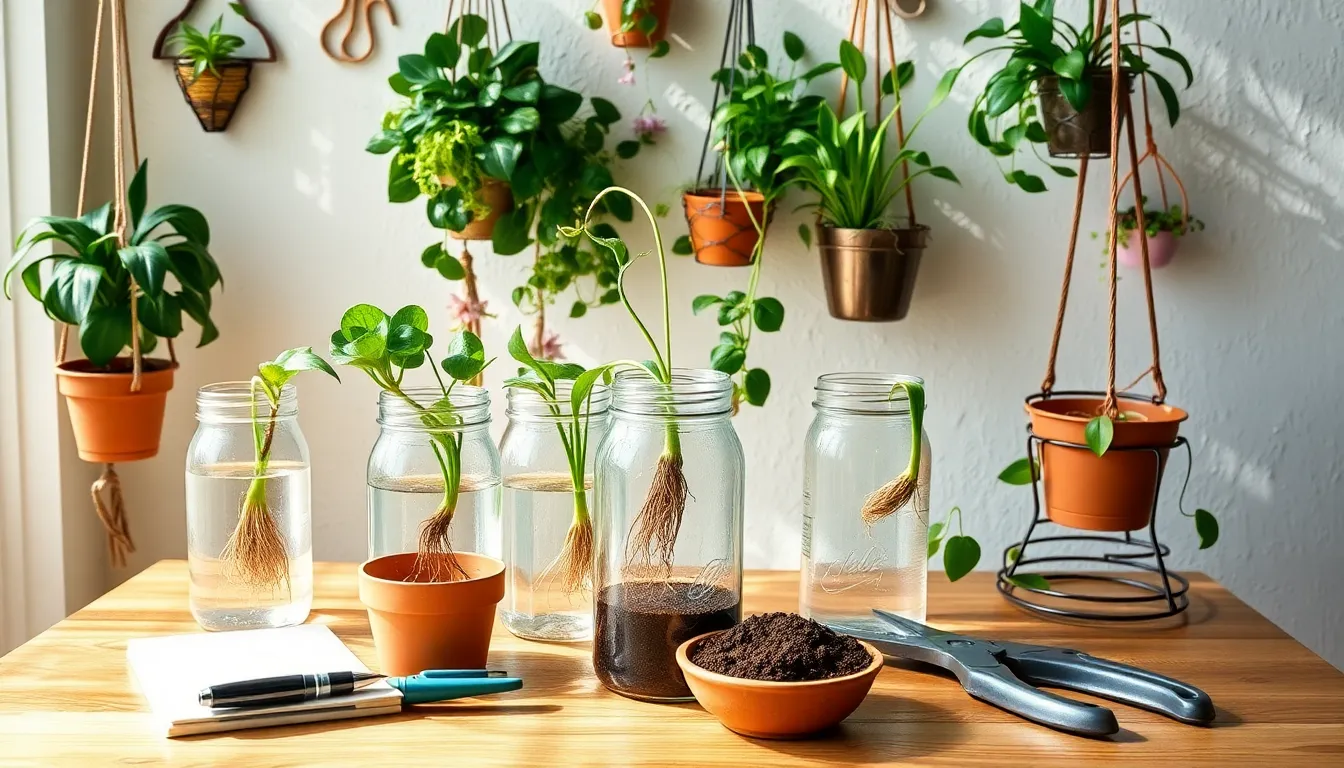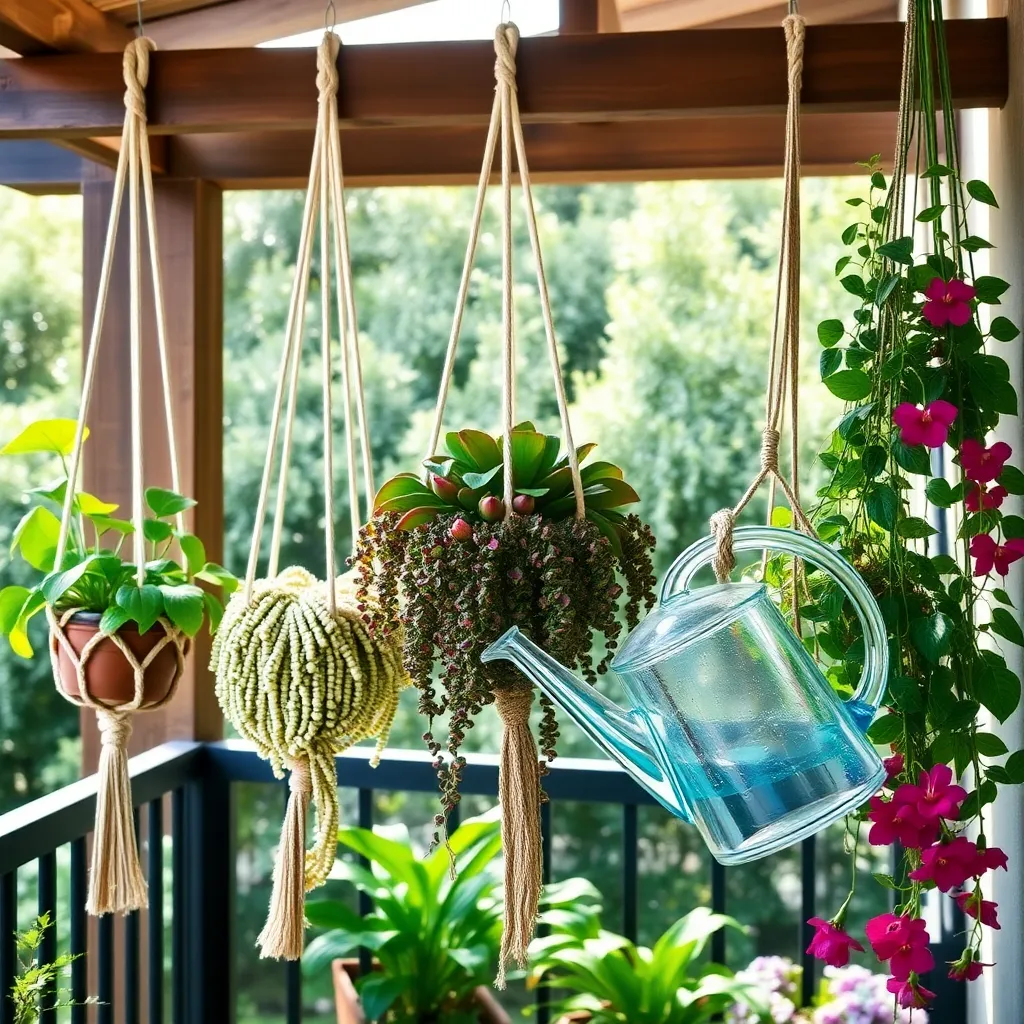Welcome to the enchanting world of indoor hanging plants, where lush foliage and cascading vines transform your living space into a vibrant oasis! Whether you’re a budding gardener just beginning your journey or a seasoned plant enthusiast looking to expand your indoor jungle, our guide to the top 12 hanging plants that thrive indoors is your ticket to success. These carefully selected plants are not just beautiful; they are resilient and adaptable, making them perfect companions for any home.
Imagine the joy of watching your home come alive with greenery, each plant adding its unique charm and personality. Our list provides you with practical insights, ensuring you can confidently nurture these plants and enjoy their myriad benefits, from improved air quality to a serene ambiance. Embrace the rewards of successful gardening as you explore each plant’s needs and characteristics, equipped with the knowledge to help them flourish. Let this guide inspire you and instill the confidence to create your own lush, hanging paradise right in the heart of your home.
Spider Plant (Chlorophytum comosum – Low Maintenance)

The Spider Plant, or Chlorophytum comosum, is a fantastic choice for anyone looking to add a touch of green to their indoor spaces. Renowned for its resilience and air-purifying qualities, this plant thrives with minimal intervention.
When it comes to care, Spider Plants prefer bright, indirect light but can tolerate low-light conditions, making them highly versatile. For optimal growth, place them near a window where they can enjoy filtered sunlight.
Watering should be done sparingly, allowing the soil to dry out between waterings to prevent root rot. Use a well-draining potting mix, such as a blend of peat, loam, and sand, to ensure healthy roots.
For those looking to propagate, Spider Plants produce offshoots or ‘pups’ that can be easily detached and potted. Advanced gardeners can encourage more pups by providing a balanced liquid fertilizer every 6-8 weeks during the growing season.
Boston Fern (Nephrolepis exaltata – Air Purifying)
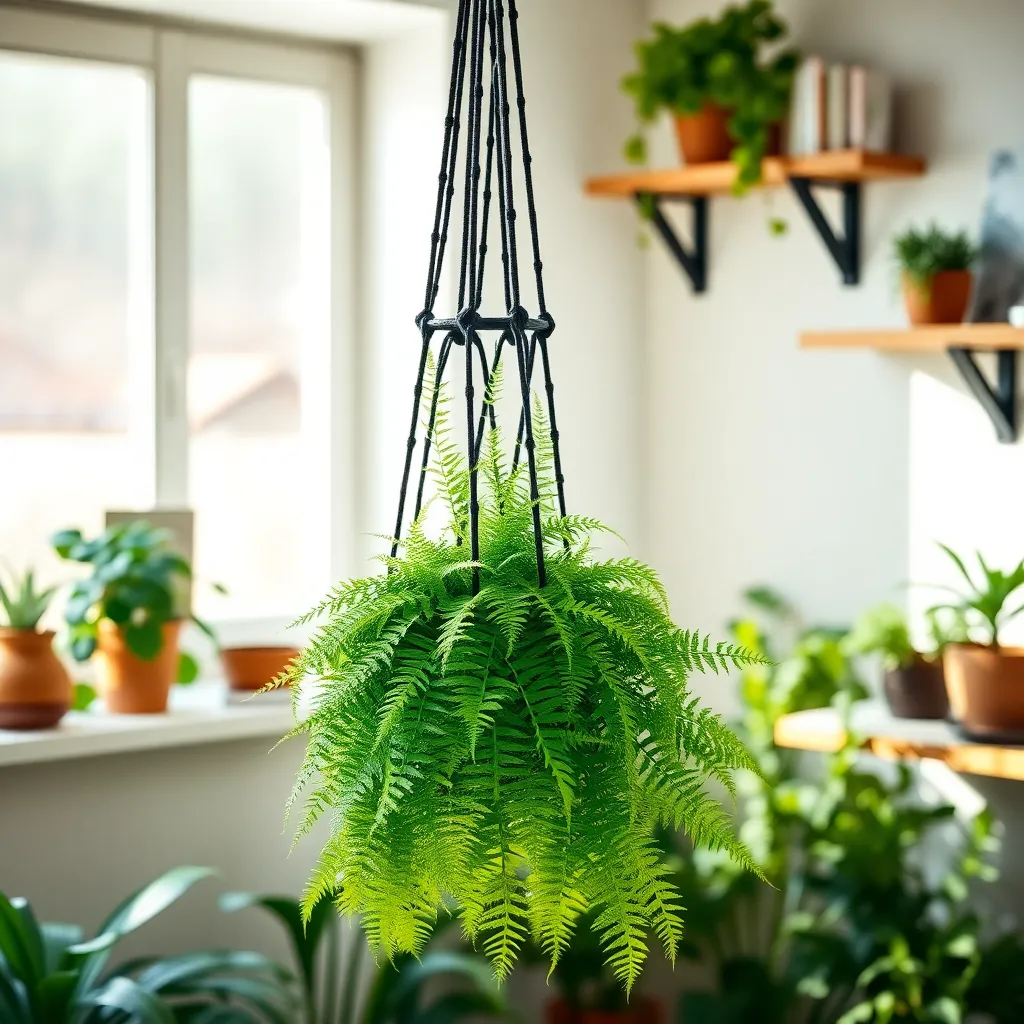
Boston Ferns, known for their lush, feathery fronds, are excellent for hanging indoors and are renowned for their air-purifying abilities. They thrive in indirect light and high humidity, making them perfect for bathrooms or kitchens where moisture is more prevalent.
To keep your Boston Fern healthy, ensure that the soil remains consistently moist but not waterlogged. A well-draining potting mix, such as one formulated for ferns or a mix of peat moss and perlite, helps provide the right balance of moisture and drainage.
Regular misting or placing the plant on a tray filled with pebbles and water can increase humidity, which these ferns love. Fertilize every month during the growing season with a balanced liquid fertilizer diluted to half-strength to encourage vibrant growth.
For more experienced gardeners, consider dividing your Boston Fern every couple of years to promote rejuvenation and prevent overcrowding. Gently remove the plant from its pot, and using a sharp knife, separate the root ball into smaller sections, ensuring each has healthy fronds and roots.
String of Pearls (Senecio rowleyanus – Unique Aesthetic)
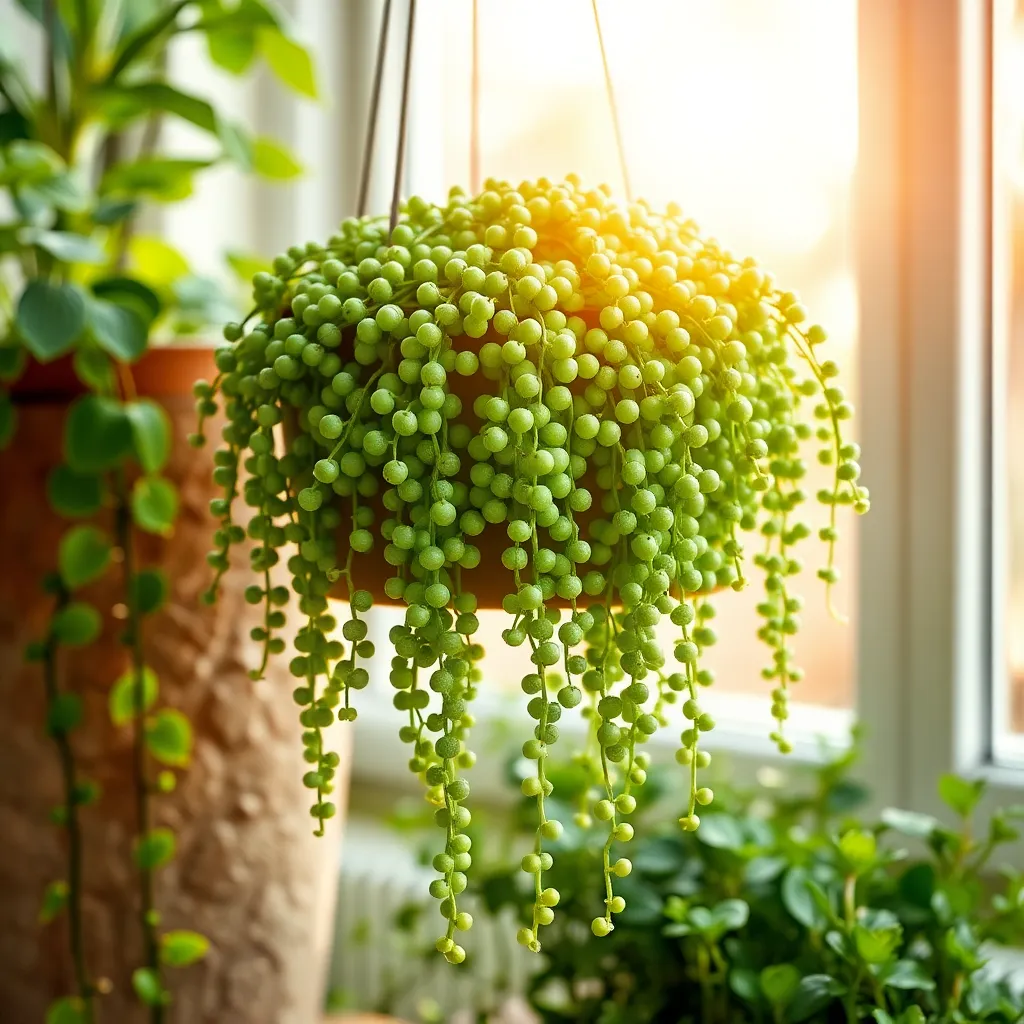
The String of Pearls (Senecio rowleyanus) offers a delightful cascade of spherical leaves that mimic a string of beads, making it a striking addition to any indoor hanging garden. This plant thrives on neglect, requiring only minimal watering, making it perfect for both beginners and busy plant enthusiasts.
For optimal growth, place your String of Pearls in a bright spot with indirect sunlight, as too much direct sun can scorch its delicate leaves. Use a well-draining cactus soil mix, which prevents water from accumulating and causing root rot.
Water sparingly, allowing the soil to dry out completely between waterings, especially during the winter months when the plant’s growth slows down. A good rule of thumb is to water every two weeks during the growing season and reduce frequency during the cooler months.
To encourage lush growth and maintain its unique spherical shape, consider propagating by taking cuttings and planting them back into the pot. Simply snip a healthy strand, let it dry for a day, and then plant in soil, ensuring the nodes are buried to support new root growth.
English Ivy (Hedera helix – Versatile Climber)

English Ivy (Hedera helix) is a classic choice for indoor hanging plants, admired for its versatile climbing ability and lush foliage. To ensure healthy growth, provide this plant with bright, indirect light, although it can tolerate lower light conditions if needed.
Ensure the soil remains evenly moist without becoming waterlogged; a well-draining potting mix is essential. Water your ivy when the top inch of soil feels dry, and avoid letting it sit in water to prevent root rot.
For beginners, it’s important to note that English Ivy can thrive with minimal fertilization, needing only a balanced houseplant fertilizer every month during the growing season. More experienced gardeners can encourage denser foliage by regularly pruning and pinching back the tips to promote bushier growth.
To enhance its climbing abilities, provide a support structure such as a trellis or allow it to cascade from a high shelf or hanging basket. With the right care, English Ivy can purify the air in your home while adding a touch of greenery to any room.
Heartleaf Philodendron (Philodendron hederaceum – Easy Propagation)
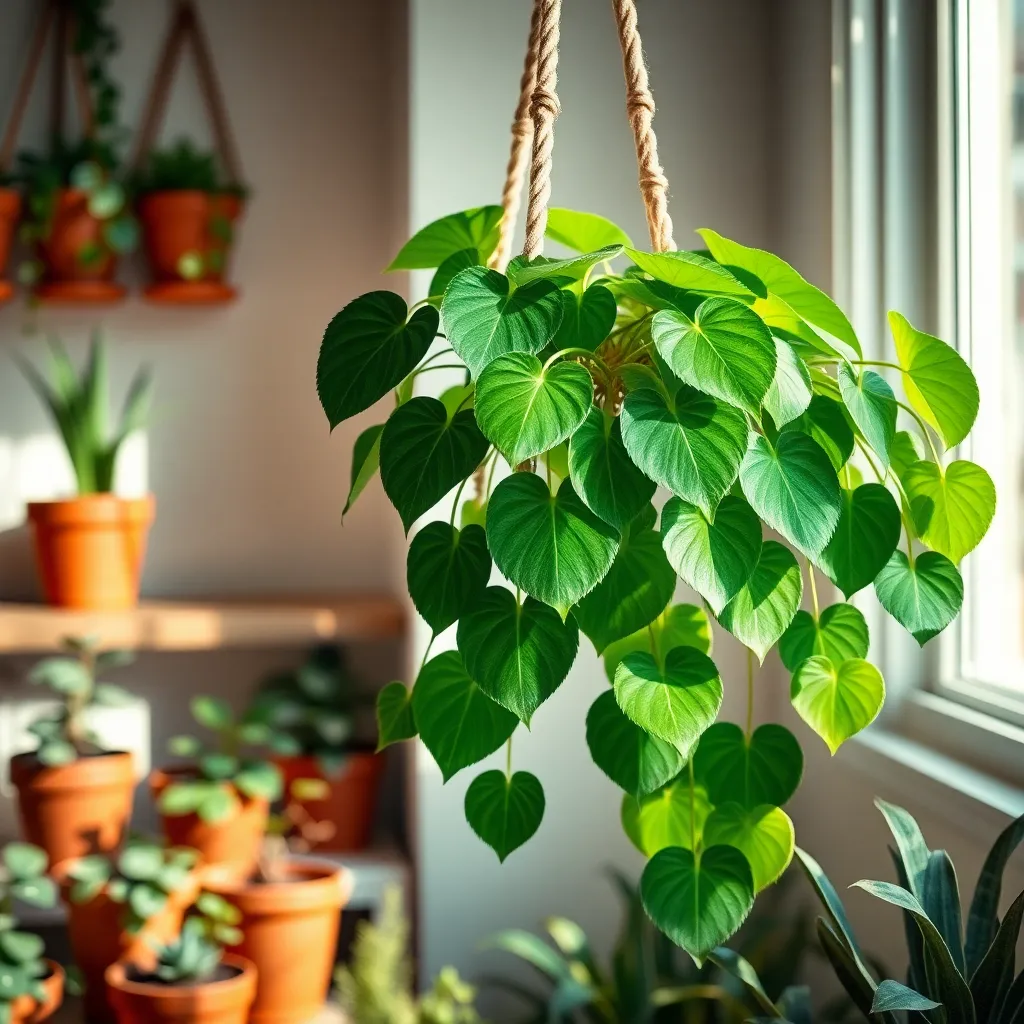
Heartleaf Philodendron (Philodendron hederaceum) is a wonderful choice for indoor hanging planters due to its lush, trailing vines and ease of care. This plant thrives in average indoor temperatures and humidity, making it an ideal option for both beginner and experienced gardeners.
To propagate this plant, simply take cuttings with at least two nodes and a few leaves, ensuring a healthy start for your new plant. Place these cuttings in water or directly into a well-draining potting mix, such as one containing equal parts peat and perlite, to encourage root development.
Once established, the Heartleaf Philodendron requires minimal maintenance. Water the plant when the top inch of soil feels dry, and provide it with bright, indirect light to prevent leaf burn and encourage vigorous growth.
For those looking to optimize growth, consider using a balanced liquid fertilizer every 4-6 weeks during the growing season. Additionally, regularly dusting the leaves and rotating the plant can help ensure even growth and maintain its vibrant appearance.
Maidenhair Fern (Adiantum – Delicate Fronds)
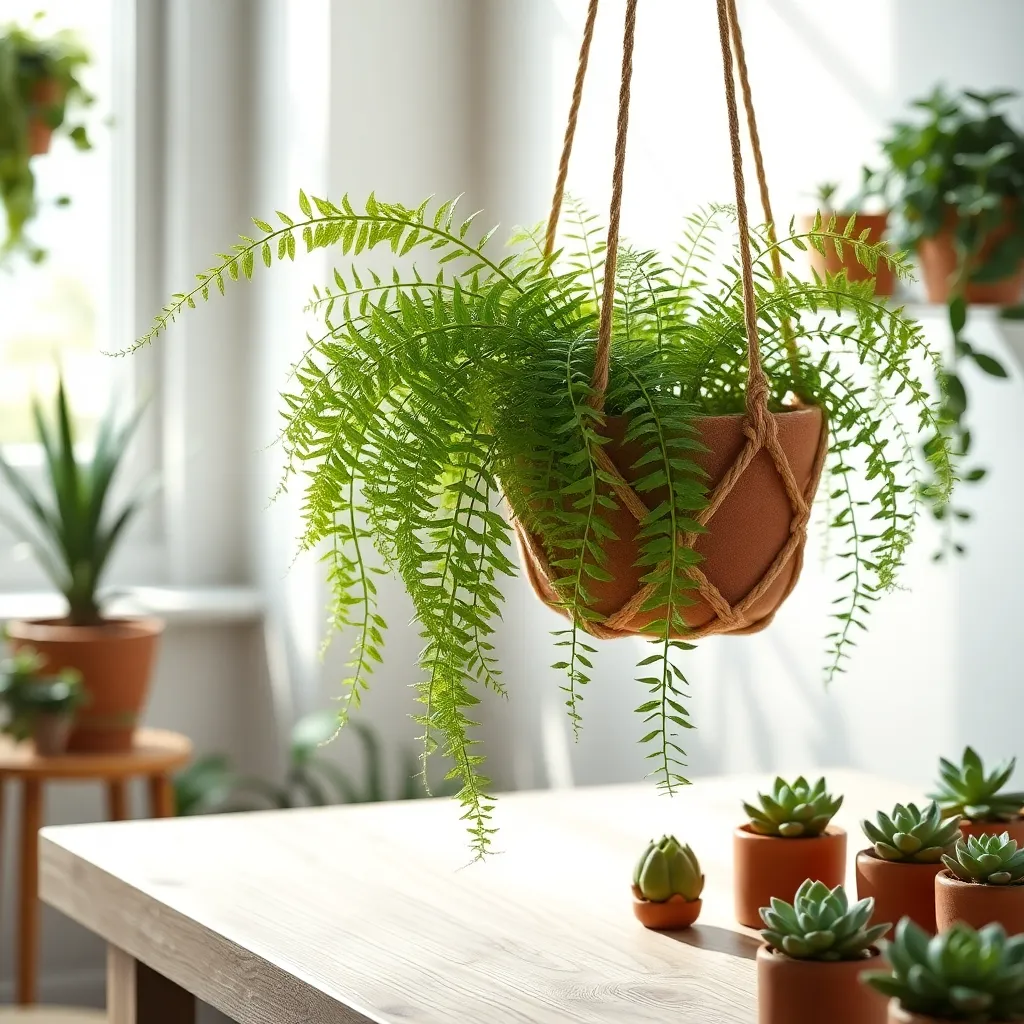
The Maidenhair Fern, known for its delicate and airy fronds, makes a stunning addition to any indoor garden with its graceful presence. This plant thrives best in a humid environment, making it an ideal choice for bathrooms or kitchens where moisture levels are naturally higher.
To care for your Maidenhair Fern, ensure it is placed in indirect light as direct sunlight can scorch its sensitive fronds. It’s crucial to keep the soil consistently moist but not waterlogged; using a soil mix rich in organic matter like peat moss or coco coir can help maintain the right balance.
Regular misting can greatly benefit this plant, especially if your home tends to be on the drier side. For those looking to advance their care, consider using a pebble tray under the pot to increase humidity levels around the plant.
For optimal growth, fertilize your Maidenhair Fern monthly during the growing season with a diluted, balanced liquid fertilizer. If you notice the fronds turning brown, it might be a sign of low humidity or insufficient watering, so adjust your care routine accordingly.
Pothos (Epipremnum aureum – Beginner-Friendly)

Pothos (Epipremnum aureum) is a versatile and easy-to-care-for indoor plant, making it a favorite among beginners. Known for its heart-shaped, vibrant green leaves, Pothos thrives in a variety of lighting conditions, from low light to bright, indirect sunlight.
To keep your Pothos healthy, water it when the top inch of the soil feels dry to the touch. Overwatering can lead to root rot, so ensure your pot has good drainage and avoid letting the plant sit in water.
For the best growth, use a well-draining potting mix, such as a blend of peat moss, perlite, and vermiculite. Fertilizing with a balanced, water-soluble fertilizer every 4-6 weeks during the growing season can boost its lushness.
Advanced gardeners might consider propagating Pothos easily through stem cuttings. Simply place a cutting in water until roots develop, then transfer it to a pot with soil for a new plant.
Hoya (Hoya carnosa – Wax-like Blooms)
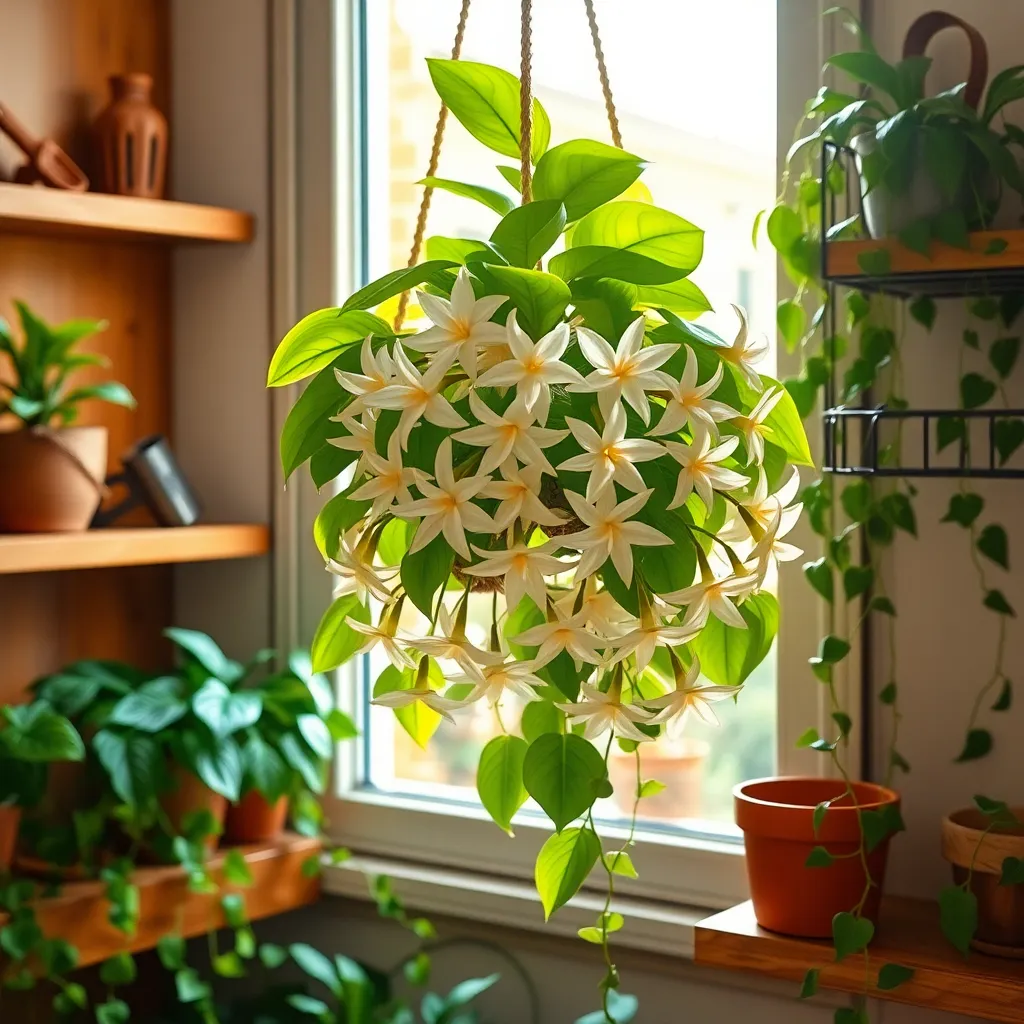
The Hoya carnosa, commonly known as the Wax Plant, is a delightful addition to any indoor hanging garden due to its stunning, wax-like blooms. This plant thrives in bright, indirect light, making it perfect for a spot near a sunny window where direct sunlight won’t scorch its leaves.
When it comes to watering, it’s essential to let the soil dry out between watering sessions. Overwatering can lead to root rot, so ensure your Hoya is potted in a well-draining soil mix, such as a blend of orchid bark, perlite, and peat moss.
For those looking to enhance their Hoya’s blooming potential, consider feeding the plant with a balanced liquid fertilizer every four to six weeks during the growing season. Additionally, providing a bit of extra humidity by misting the leaves can mimic the plant’s natural tropical environment and promote healthier growth.
To propagate, cut a healthy stem with a few leaves and place it in water or directly into a moist soil mix. With a little patience, you’ll soon see roots developing, allowing you to share this beautiful plant with friends or expand your own collection.
Burro’s Tail (Sedum morganianum – Succulent Charm)
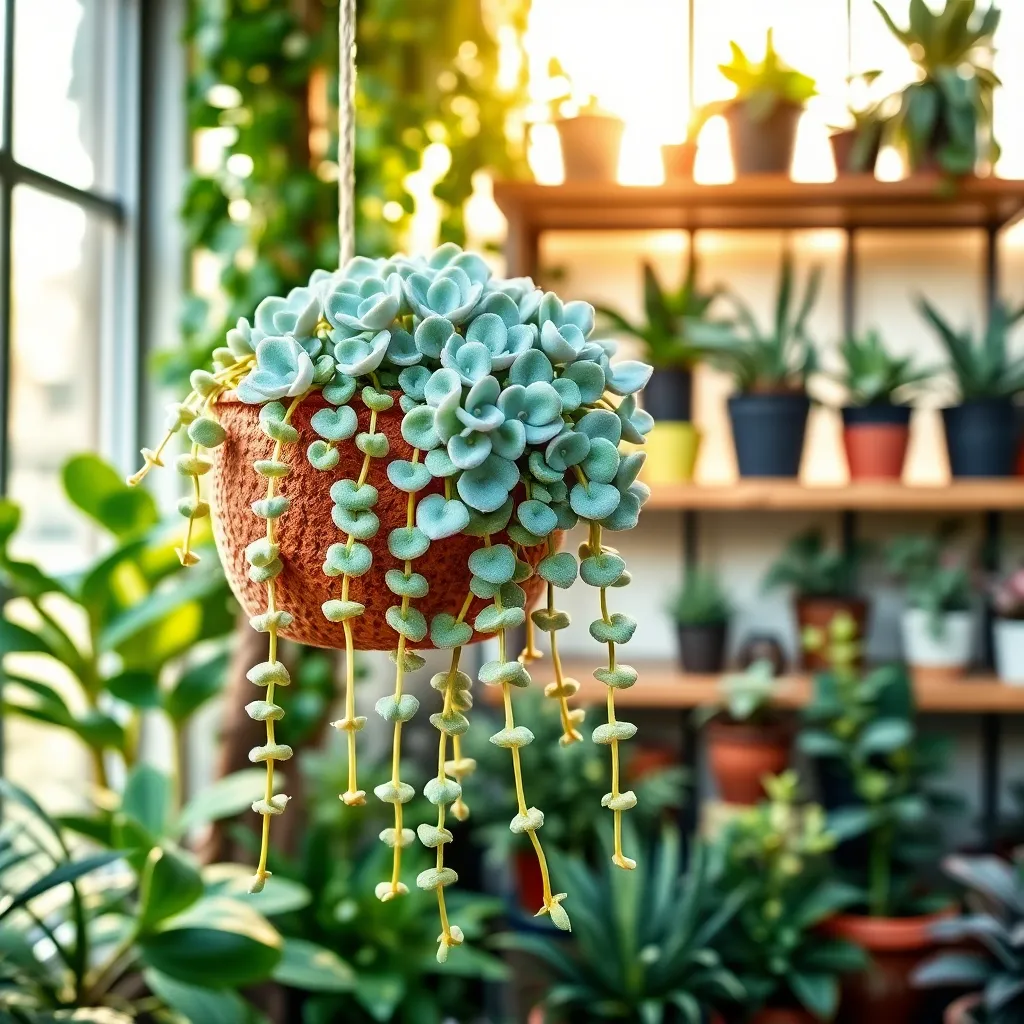
Burro’s Tail, also known as Sedum morganianum, is a delightful succulent popular for its cascading, bead-like leaves. Perfect for hanging baskets, this plant adds an elegant touch to any indoor space.
To keep your Burro’s Tail thriving, place it in a location that receives bright, indirect sunlight. Direct sunlight can scorch the leaves, so a spot near a window with filtered light is ideal.
Watering this succulent requires a gentle balance; it’s best to water only when the soil is completely dry. Overwatering can easily lead to root rot, so using a well-draining soil mix is crucial.
For advanced care, consider feeding your Burro’s Tail with a diluted, balanced fertilizer during the growing season. Pinching back the tips occasionally will encourage a fuller, more compact growth habit.
Staghorn Fern (Platycerium – Sculptural Appeal)

The Staghorn Fern (Platycerium) is a unique addition to any indoor space, offering a sculptural appeal that sets it apart from typical houseplants. These ferns mimic their natural epiphytic environment when hung, making them ideal for hanging baskets or mounted on wooden boards, which allows their intriguing fronds to cascade gracefully.
To thrive indoors, Staghorn Ferns require indirect, bright light, mimicking the dappled sunlight they would receive under a forest canopy. Water them once a week, ensuring the root ball is soaked thoroughly, then allow it to dry out slightly between waterings to prevent root rot.
For optimal growth, use a loose, well-draining mix such as a blend of sphagnum moss and orchid bark, which provides the aeration these epiphytes need. Feeding your Staghorn Fern with a diluted balanced fertilizer every two to three months during the growing season will promote lush, vigorous growth.
More experienced gardeners can experiment with propagating these plants by carefully dividing the pups that grow at the base of mature ferns. This not only expands your collection but also invigorates the parent plant by giving it more space to grow.
String of Hearts (Ceropegia woodii – Dainty Vine)
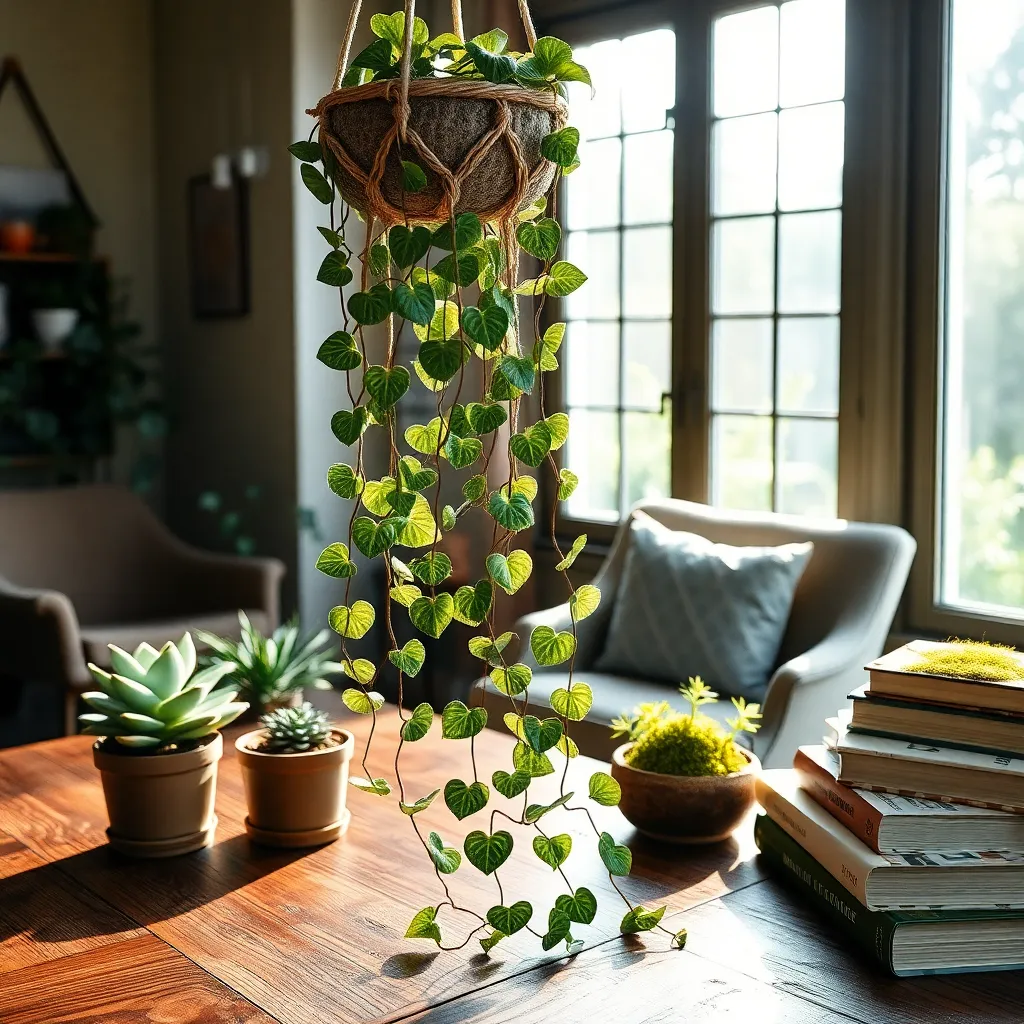
The String of Hearts, also known as Ceropegia woodii, is a charming and easy-to-grow hanging plant that can bring life to any indoor space. Its delicate, heart-shaped leaves cascade beautifully, making it a favorite among plant enthusiasts looking for a touch of elegance in their homes.
To keep your String of Hearts thriving, place it in a spot where it receives bright, indirect sunlight, as direct sun can scorch its leaves. If natural light is limited, consider using a grow light to provide the necessary illumination, especially during the shorter days of winter.
Watering is crucial for this plant; allow the top inch of soil to dry out between waterings to prevent root rot. Overwatering is a common mistake, so it’s better to err on the side of underwatering, especially in cooler months.
For optimal growth, use a well-draining potting mix, such as a cactus or succulent blend, to ensure that excess water can escape easily. Fertilize sparingly during the growing season with a diluted, balanced liquid fertilizer to promote healthy growth.
Advanced gardeners can propagate the String of Hearts by laying a stem on top of the soil and securing it with a pin or by rooting cuttings in water. This is a rewarding way to expand your collection or share with friends, enriching your indoor garden with effortless charm.
Bird’s Nest Fern (Asplenium nidus – Glossy Leaves)
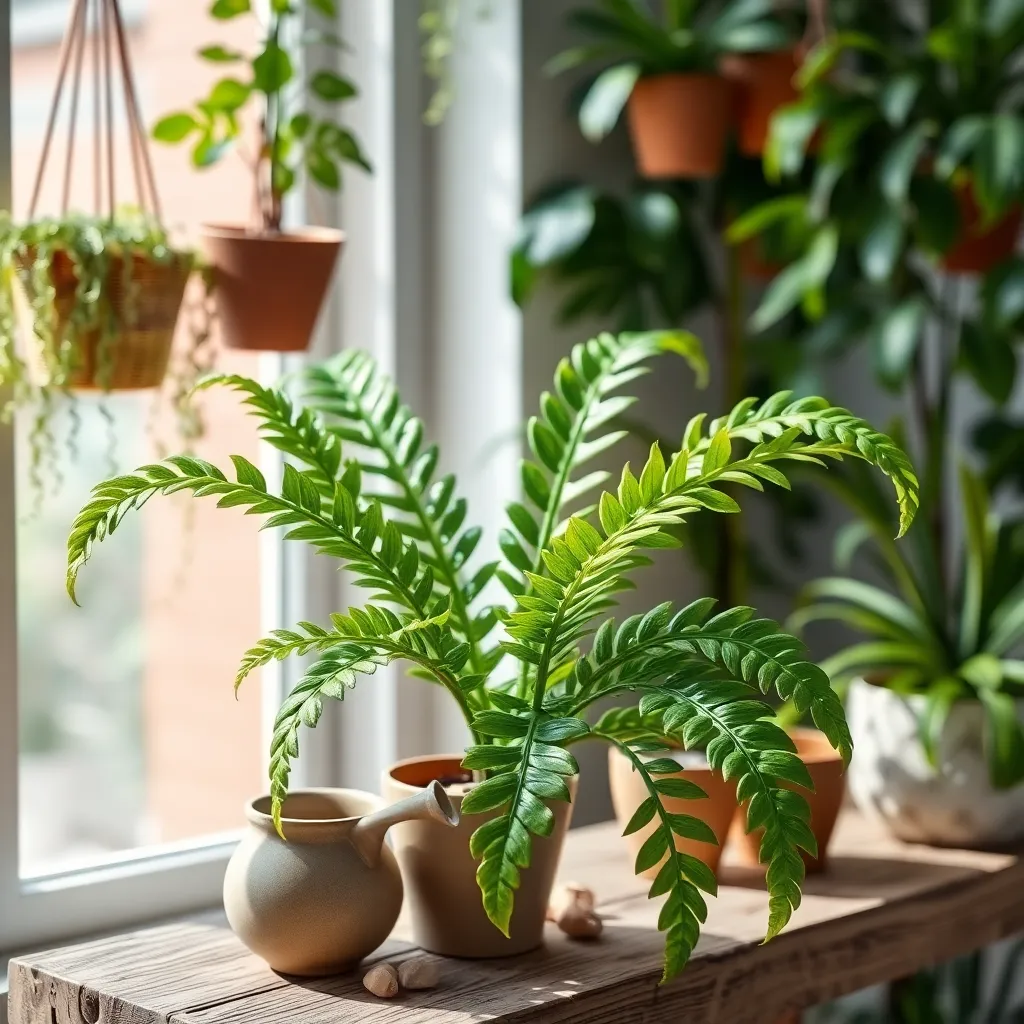
The Bird’s Nest Fern (Asplenium nidus) is a stunning houseplant known for its lush, glossy leaves that can brighten any indoor space. This fern thrives in indirect light, making it perfect for rooms with limited natural sunlight, such as bathrooms or living rooms with east-facing windows.
To keep your Bird’s Nest Fern healthy, ensure it is planted in a well-draining potting mix, ideally a peat-based mix with added perlite. Maintain consistent moisture by watering it once the top inch of soil feels dry, but avoid waterlogging, as this can lead to root rot.
Humidity is crucial for this tropical plant, so consider placing it near a humidifier or on a tray of pebbles and water to boost air moisture. As an advanced tip, mist the leaves occasionally with a spray bottle to mimic its natural rainforest habitat, promoting healthier growth.
Fertilize your Bird’s Nest Fern monthly during the growing season with a diluted balanced liquid fertilizer to support its vibrant foliage. Pruning isn’t necessary for this fern, but remove any yellowing or damaged fronds to maintain its attractive appearance and encourage new growth.
Conclusion: Growing Success with These Plants
In exploring the ‘Top 12 Hanging Plants That Thrive Indoors,’ we’ve uncovered a dozen key concepts that mirror the nurturing elements of successful relationships. From the resilient Spider Plant that teaches adaptability, to the soothing presence of a Heartleaf Philodendron that reminds us to cultivate warmth and empathy, each plant embodies a unique relationship virtue. The Maidenhair Fern highlights the importance of patience, while the String of Pearls emphasizes the beauty of balance and harmony. By understanding these botanical analogies, we can enrich our relationships with growth, resilience, and care.
To put this newfound wisdom into practice, choose one plant that resonates with your current relationship dynamic and bring it into your home. Let it serve as a daily reminder of the qualities you wish to nurture. As you embark on this green journey, save this article for easy reference, ensuring these insights remain at your fingertips.
Remember, just like these plants, relationships require ongoing attention and care. By fostering these qualities, your relationships can thrive and flourish, creating a future filled with connection and joy. Bookmark this guide as your go-to resource for ongoing inspiration and growth, and take the first step towards cultivating relationships that truly blossom.

